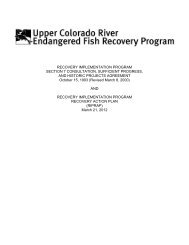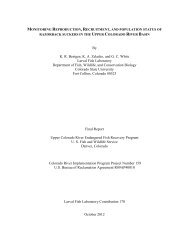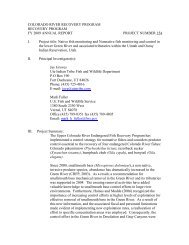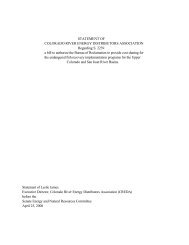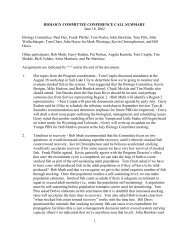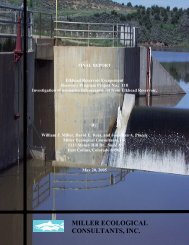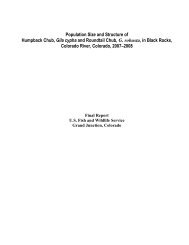Final Programmatic Biological Opinion for Bureau of Reclamation's
Final Programmatic Biological Opinion for Bureau of Reclamation's
Final Programmatic Biological Opinion for Bureau of Reclamation's
You also want an ePaper? Increase the reach of your titles
YUMPU automatically turns print PDFs into web optimized ePapers that Google loves.
45Analyses <strong>for</strong> Effects <strong>of</strong> the ActionWater QuantityWater depletions have/will cause discrete, identifiable, additive, adverse impacts to the ColoradoRiver endangered fishes. As shown in the following flow analysis, the action subject toconsultation has/will cause flow depletions that alter baseline flow regimes. The proposed actionis intended to result in the continued existing depletion <strong>of</strong> water as well as new depletions up to120,000 acre-feet/year beyond existing levels. Existing depletions are defined under thedescription <strong>of</strong> the proposed action.Quantification <strong>of</strong> depletion impacts have focused on the 15-Mile Reach <strong>for</strong> four reasons. First,the Service considers the 15-Mile Reach to be especially important habitat <strong>for</strong> the Coloradopikeminnow and razorback sucker. Second, the Service has developed flow recommendations <strong>for</strong>the 15-Mile Reach against which current flows can be compared. Numerous studies <strong>of</strong> habitatand habitat needs have been conducted in the 15-Mile Reach. Third, the 15-Mile Reach is themost depleted reach on the Colorado River because it is located upstream <strong>of</strong> the Gunnison Riverconfluence and immediately downstream <strong>of</strong> the large diversions at and above Palisade;consequently, a reduction in flow will impact the 15-Mile Reach to a greater degree than the otherreaches. Fourth, almost any action which <strong>of</strong>fsets depletion impacts to the 15-Mile Reach willnecessarily <strong>of</strong>fset depletion impacts to the reaches downstream to the confluence with the GreenRiver because there are no major diversions below the 15-Mile Reach.To determine the effects <strong>of</strong> the existing and future levels <strong>of</strong> depletions on water quantity andalteration <strong>of</strong> the hydrologic regime, an analysis <strong>of</strong> flow changes was conducted. This analysiscompares existing conditions, future conditions (60,000 acre-feet/year and 120,000 acre-feet/year<strong>of</strong> additional depletion), the environmental baseline conditions (baseline flow conditions), and 15-Mile Reach flow recommendations.The State Model was used to model existing conditions and future depletions. Two levels <strong>of</strong>future demands were added to the model immediately downstream <strong>of</strong> Cameo: 60,000 and120,000 acre-feet per year. These demands were imposed in the following distribution:Oct Nov Dec Jan Feb Mar Apr May Jun Jul Aug Sep Total 31200 1200 1200 1200 1200 1200 1200 19200 24000 6000 1200 1200 60,0002400 2400 2400 2400 2400 2400 2400 38400 48000 12000 2400 2400 120,000These distributions were based primarily on when the water would physically be available. Theresulting depletions in the modeling were very close to these demands. The average depletionsover the study period were 59,082 and 118,165 acre-feet per year, respectively.3 Distribution was developed by Leonard Rice Consulting Water Engineers.



